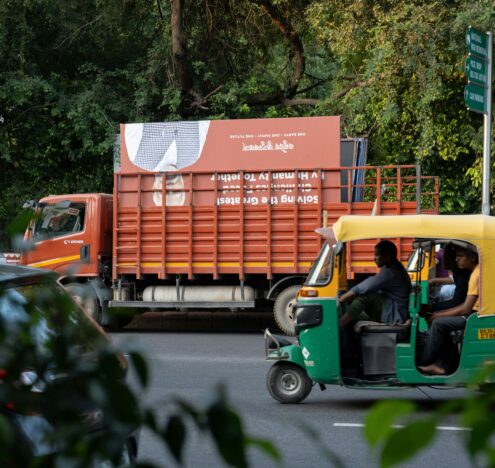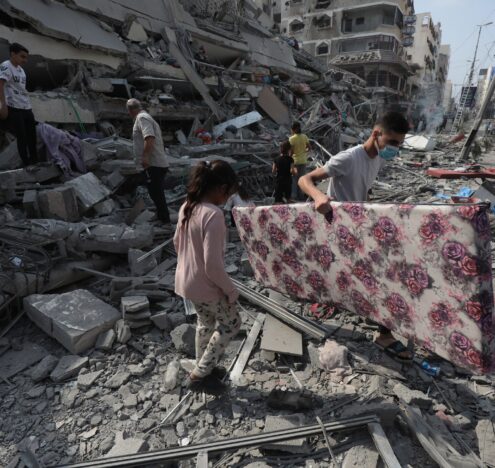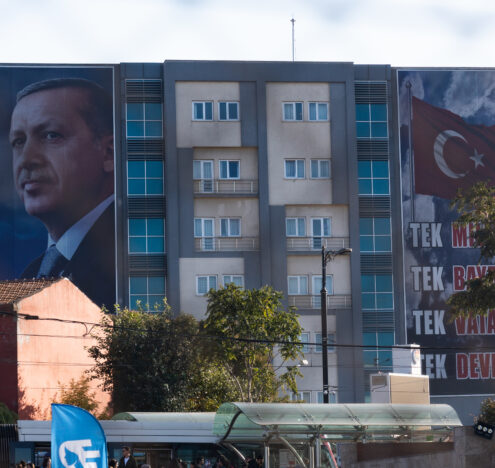For something very few people will ever see with their own eyes, nuclear weapons are remarkably ever-present in our lives. Currently, nine countries possess around 12,700 nuclear weapons (including over 3,200 retired warheads awaiting dismantlement) and many experts fear the risk of a nuclear war is higher now than it has been in decades.
Since entering into force in 1970, the Treaty on the Non-Proliferation of Nuclear Weapons (NPT) has been a legally binding instrument intended to prevent the spread of nuclear weapons, advance peaceful uses of nuclear energy, and oblige nuclear-armed nations to achieve complete disarmament.
Every five years, the 191 state parties convene for the NPT review conference to discuss how to fulfill the obligations of the treaty. And while nuclear proliferation has been far less widespread than many had feared and stockpiles have been reduced dramatically since the global peak in the mid-1980s, arguably the most important part of the NPT, Article VI, remains elusive. Article VI of the NPT reads:
“Each of the Parties to the Treaty undertakes to pursue negotiations in good faith on effective measures relating to cessation of the nuclear arms race at an early date and to nuclear disarmament, and on a treaty on general and complete disarmament under strict and effective international control.”
In particular, the five officially recognized nuclear weapon states (Russia, the United States, China, France, and the United Kingdom) continue to hold onto their nuclear weapons tightly, expanding, modernizing, and developing new weapons and delivery systems, even as some have reduced their overall numbers. None of the five demonstrate any sign of ending the nuclear arms race or complete nuclear disarmament “at an early date.”
The nuclear weapon states have all steered clear of TPNW even as previously resistant nations begin to show the first signs of greater openness to the treaty.
Cold War-era fears of all-out nuclear war and a catastrophic nuclear winter, until recently considered a thing of the past, have risen to the fore as tensions escalate and arms control treaties wither. Just last week, Russian President Vladimir Putin threatened to use “all available means” to protect Russia (or Russian-held territory), adding “it’s not a bluff.”
Last month, during the tenth review conference in New York, Andrew Facini tweeted a list of some of the more troubling developments since the last conference in 2015, including abandoned and collapsed arms treaties, intensified nuclear modernization, a rapid acceleration of new weapons technology, and heightened tensions and border clashes between nuclear-armed states. These events occurred during the same period when former President Donald Trump was making multiple — explicit and implicit — threats to use nuclear weapons.
This dark turn in the global security environment was even before Russia’s February 2022 invasion of Ukraine when Putin threatened anyone trying to stop Russia with “consequences that you have never faced in your history.” Since then, Europe’s largest nuclear power plant (based in Ukraine) has been transformed into a potentially catastrophic battle zone and in August 2022, Russia suspended on-site inspection under the New START Treaty.
Earlier this month, Ukraine’s top military commander warned that Russia might use tactical nuclear weapons. Meanwhile, other longstanding flashpoints on the borders of Pakistan, India, and China, as well as the Taiwan Straits and the Korean Peninsula remain volatile. In the last few weeks, the United States conducted two inter-continental ballistic missile test launches to demonstrate the readiness and lethality of its nuclear weapons. Speculation that North Korea may be preparing for a new explosive nuclear test is ongoing as Kim Jong-un vowed his country would never give up its nuclear weapons.
Running Out of Patience
Among the majority of the world’s countries that do not have nuclear weapons, there is a growing sense of frustration for what is seen as backsliding, foot-dragging, and a general unwillingness to make sufficient progress by nuclear weapon states on fulfilling their obligations under the NPT.
Inspired by international treaties banning biological and chemical weapons, landmines, and cluster munitions, a years-long movement by the International Campaign to Abolish Nuclear Weapons (ICAN) and others culminated in the Treaty on the Prohibition of Nuclear Weapons (TPNW), which calls for the complete elimination of nuclear weapons and was adopted by a vote of 122 UN member states in 2017.
The TPNW entered into force in January 2021. Currently, 68 nations, more than seven times the number of countries that possess nuclear weapons, have ratified the TPNW, informally called the “ban treaty.” Unlike the NPT, the ban treaty prohibits all state parties from developing, testing, producing, manufacturing, possessing, stockpiling, transferring, receiving, or threatening to use nuclear weapons.
TPNW states parties include countries as diverse as Fiji, Mongolia, Bolivia, Kazakhstan, Ireland, Mexico, New Zealand, Gambia, and Thailand, all of whom have vowed they will not possess or pursue nuclear weapons. They want all nine nuclear-armed countries to join them but those nations reject the ban treaty, calling it ineffective and incompatible with the NPT.
Meeting of States Parties
In June, the first Meeting of States Parties to the TPNW convened in Vienna. The meeting was overseen by Ambassador Alexander Kmentt, director for disarmament, arms control, and nonproliferation for Austria’s Ministry for Europe and international affairs.
While nuclear-armed states and some allies argue that the current global security environment is too fraught to make disarmament progress, the majority of other states say that the current global nuclear risk environment demands progress on nuclear disarmament be made sooner than later.
Kmentt argues that staking the livability of our planet on luck and hope is not a tenable long-term strategy as international security hovers near the breaking point. In the recent words of UN Secretary-General Antonio Guterres, humanity is “just one misunderstanding, one miscalculation away from nuclear annihilation.”
“Is it necessary that something absolutely hideous happens? Do we have to see the use of a tactical nuclear weapon somewhere in order to get people talking about it again? I hope not,” said Kmentt.
In addition to the non-nuclear nations who attended the Meeting of States Parties to the TPNW, a number of countries that are skeptical of the ban treaty, including NATO members Germany, Belgium, the Netherlands, as well as Finland and Sweden (who have applied to NATO), and also Switzerland and Australia, participated as observers.
The ministry of foreign affairs of another NATO observer, Norway, said in a statement: “Norway stands fully behind NATO’s nuclear posture. However, we acknowledge that the TPNW has entered into force, and we recognize that 86 countries have signed it. We seek a constructive dialogue between all states to advance nuclear disarmament and counter polarization in this area, even though we may have chosen different paths and tools to move towards zero.”
The nuclear weapon states have all steered clear of TPNW even as previously resistant nations begin to show the first signs of greater openness to the treaty.
In response to the nuclear weapon states’ aversion to the TPNW, Kmentt said, “Not engaging with a large number of states that are doing something in good faith is actually not a serious position.” That stubborn resistance by persistent objector nations like the United States and the United Kingdom, he said, demonstrates a fear that TPNW will create a customary international law norm against nuclear weapons.
Humanitarian Impacts
One important aspect of the Meeting of States Parties, Kmentt said, was coupling policy talks with a conference on the humanitarian impacts of nuclear weapons. He added that by broadening the disarmament discussion from expert-level nuclear deterrence doctrine and international legal arguments to the more relatable and undeniable humanitarian stakes of using nuclear weapons gives agency to non-nuclear weapon states who are usually disenfranchised in this debate.
“Normally these issues are discussed in expert security policy circles who have very sophisticated terminology on nuclear deterrence doctrine and things like that,” Kmentt said. He suggested that when the discussion is broadened to include humanitarian consequences and environmental impacts, it introduces new, typically unheard voices from civil society and citizens of non-nuclear states who can offer powerful testimony and arguments on the urgent need to eliminate nuclear weapons.
People in Washington DC don’t recognize the power and extent of what TPNW represents or how consequential the treaty is. I think nuclear powers are still in denial… the conversation in the global nuclear field is progressing much faster than nuclear powers are ready to acknowledge.
Togzhan Kassenova
The one-day conference highlighted the latest peer-reviewed scientific findings including a sobering new report that examines how atmospheric pollutants resulting from a nuclear detonation could rapidly and dramatically affect the global climate, causing prolonged disruption — possibly even a collapse — of agriculture, food production, and global trade that would result in widespread hunger, famine, and the deaths of billions of people.
One of the presenters at the conference was Togzhan Kassenova, a nuclear researcher and author of “Atomic Steppe: How Kazakhstan Gave up the Bomb.” Kassenova was struck by the energy surrounding the TPNW. “I think this is one of the most democratic treaty processes ever,” she said. “It was amazing to see so much excitement and good representation in age, race, ethnicity, and religions from different parts of the world.”
Kassenova noted how few participants were from the Washington think tank, academic or political spheres. “People in Washington DC don’t recognize the power and extent of what TPNW represents or how consequential the treaty is,” Kassenova said. “I think nuclear powers are still in denial… The conversation in the global nuclear field is progressing much faster than nuclear powers are ready to acknowledge.”
Also present in Vienna was Benetick Kabua Maddison, executive director of the Arkansas-based non-profit Marshallese Education Initiative. Born in the Marshall Islands, Kabua Maddison said the meeting of states parties in Vienna brought together people from other nuclear-affected communities who had so much in common, despite their different backgrounds.
Kabua Maddison described the ban treaty meeting as far more open and welcoming to civil society than the NPT review conference which he also attended in August. There he helped deliver an international joint youth statement that lambasted nuclear weapon states on behalf of a generation who was “born into a nuclear regime that [they] neither built nor consented to.”
Like others who were deeply dissatisfied with what they described as the exclusionary nature of the NPT review conference, Kabua Maddison expressed frustration with the process and results.
Lamenting a lack of timeline or benchmarks for complete nuclear disarmament, he said, “It seems like governments are moving very slowly, obviously…we don’t have 50 more years. We need to address this issue now.”
He also noted the lack of nuclear-affected people at the review conference, asking, “where are places like French Polynesia? Where are people from the Navajo-Diné nation? Where are the people from Kazakhstan, Kiribati, from aboriginal lands in Australia, and other affected communities, because we didn’t see these people at NPT.”
Failure to Reach Consensus (Again)
After COVID caused a two-year delay, the NPT’s Tenth Review Conference, also called the NPT RevCon, convened at UN headquarters in August 2022. After nearly one month of intensive negotiations, the states parties were unable to conclude a consensus document for the second consecutive conference.
During the closing plenary session, the frustration by all was palpable. State parties had completed a final conference document but the Russian delegation objected to language about the invasion and war against Ukraine and blocked the document.
In a closing statement, South Africa’s Ambassador Nozipho Joyce Mxakato-Diseko expressed disappointment and dismay, adding that two back-to-back failures to reach consensus plunged the NPT into “unchartered waters” saying, “our treaty is in deep trouble.”
“This lack of consensus, marking 12 years of failure, is a stark reminder of the length nuclear weapon states are willing to go to retain nuclear weapons unchecked and to put their narrow selfish interests ahead of the collective peace and security of the rest of humanity,” she said.
She added that the 1995 indefinite extension of the NPT did not give nuclear weapon states the right to indefinite possession and that Article VI required they relinquish their arsenals and that it is time to accept the reality of the TPNW and its consistency with the NPT.
The United Kingdom’s Permanent Representative to the Conference on Disarmament in Geneva Ambassador Aidan Liddle also expressed disappointment in not reaching a consensus but said he was encouraged by the fact that all countries bar one (Russia) were prepared to adopt a consensus document, even as imperfect as it was.
“Almost every country in the room was willing to compromise for the sake of doing something they believed would be good for the NPT and would demonstrate the strength of the NPT while it is under incredible strain given world events,” Liddle said in a video call from Geneva.
In response to withering criticism by non-nuclear states, Liddle said, “Those countries have tended to group the nuclear weapon states together and treat us as one homogeneous block, and I think actually if this RevCon has shown anything, it’s that we are not,” Liddle said. “I think that’s a big turning point for this review conference. I don’t think particularly China and Russia can hide anymore from that.”
Compared to the nuclear arsenals of Russia and the United States, and China’s much lower (but growing) stockpile, at less than 225 warheads, the United Kingdom’s arsenal is small. In 2021, however, the United Kingdom announced it was raising the upper cap on its nuclear stockpile to 260 which had been reported as an increase of over 40%.
Liddle and others have disputed those figures, arguing the numbers reported in the media were inaccurate and based on comparisons to earlier aspirational lower caps. The actual increase in the UK nuclear stockpile, he (and others) say, is just over 15%. Liddle said raising the UK’s nuclear cap is not because it wants a bigger arsenal, but because the minimum credible number needed to deter threats against it has increased.
Asked if expanding its arsenal was consistent with the commitment to disarm under Article VI, Liddle said, “The short answer is yes. The legalistic answer is that all Article VI actually obliges the nuclear weapon states to do is to negotiate in good faith on effective measures,” which he says the United Kingdom has done and continues to do.
Among the majority of the world’s countries that do not have nuclear weapons, there is a growing sense of frustration for what is seen as a general unwillingness to make sufficient progress by nuclear weapon states on fulfilling their obligations under the npt.
By comparison, Liddle said Russia was developing a host of new weapons systems and had violated the Intermediate-Range Nuclear Forces treaty and China is “going gangbusters.” “Compared to what Russia and China has done, and is continuing to do,” Liddle said UK increases were “a drop in the ocean.”
And while Liddle agreed that the United Kingdom “absolutely” has a duty to disarm, it also has a duty to maintain the credibility of its nuclear deterrent and guarantee the security of itself and its allies.
Asked if the United Kingdom would send observers to future TPNW meetings, Liddle explained, “We’re not going to be signing the TPNW. It’s not a treaty that we have any connection with. We weren’t involved in its negotiation, and it really is designed to undermine the very basis of our security and that of our allies,” by delegitimizing nuclear deterrence as a tool of statecraft.
The United Kingdom is a state party of the NPT and, Liddle said, “that’s the treaty we concentrate on. That’s the treaty we are bound by. That’s the treaty that forms part of international law as far as we’re concerned and that’s the treaty by which we’re going to achieve a world without nuclear weapons while limiting the spread of nuclear weapons as well.”
He called the elimination of nuclear weapons a “wicked problem.” With the lack of trust between the five nuclear weapon states, he said, “there is no way any one of the five countries will go first or go out of step with the other four.”
He said that “while nuclear weapons exist, they need to be maintained and they need to be safe and secure,” adding, “while you maintain the nuclear deterrent, you need to maintain it operationally ready, obviously, if it’s going to be a credible deterrent.”
Not Your Grandmother’s Arms Control
In written comments provided three weeks after the conclusion of the review conference, US Under Secretary for Arms Control and International Security Ambassador Bonnie Jenkins addressed questions about both NPT and TPNW supporter efforts to achieve nuclear disarmament. Like her UK counterpart, she said, “as long as nuclear weapons exist, the US will maintain a safe, secure, and effective nuclear deterrent and strong and credible extended deterrence commitments to our allies.”
When asked about the US commitment to fulfilling its Article VI obligations even as it modernizes its arsenal, develops and fields new weapon systems, and expands plutonium pit production, Jenkins stressed that the United States has been “very transparent about its nuclear plans, posture, and policies” and “remains committed to the goal of advancing nuclear disarmament in a way that takes into account and seeks to improve the security environment, so as to ensure that we defend the rule-based international order, deter aggression, and prevent war.”
US nuclear modernization plans are in no way an indication of arms racing, she insisted, “but rather a replacement of our aging arsenal that maintains its existing roles.” She added that the United States is working to expand risk reduction measures, increase transparency, and enhance strategic stability.
Regarding engagement with TPNW supporters, Jenkins said, “it is completely incorrect to say we have been unwilling to engage.” According to Jenkins, the US has engaged with and held bilateral meetings with TPNW-supporting nations and civil society organizations to discuss both disarmament and the humanitarian effects of nuclear war.
“In fact,” she wrote, “the United States have had very substantive discussions with several TPNW proponents as part of the Creating an Environment for Nuclear Disarmament initiative and plan to resume face-to-face discussions later this year.” Jenkins also noted that she has personally engaged TPNW states and civil society on the treaty.
She said the United States welcomes more and deeper public engagement on nuclear issues. “It is through increased interest that we can get the new voices, new ideas, new approaches, and new energy that we need to continue progress toward creating a world without nuclear weapons,” Jenkins said.
In 2017, Jenkins established a nongovernmental organization called Women of Color Advancing Peace, Security and Conflict Transformation to bring these issues to wider communities and encourage more public engagement on nuclear and security issues.
A Bright Spot
In response to the outcome of the NPT review conference, ICAN Policy and Research Coordinator Alicia Sanders-Zakre said in an email, “The unfortunate reality of the NPT is that the goodwill of the vast majority of the countries that are state parties to make progress on its implementation has been repeatedly blocked by the nuclear-armed minority.”
She said that following the first Meeting of States Parties of the TPNW conference in June 2022, member states agreed to a 50-point action plan to advance nuclear disarmament and address the harm nuclear weapons have caused around the world. They also agreed to a declaration condemning nuclear threats following Russia’s invasion of Ukraine. By contrast, she said, “The countries that have joined the Nuclear Non-Proliferation Treaty met for one month in August and adopted nothing.”
The TPNW, which she called a “bright spot in a bleak international security environment” makes it clear that most countries want to outlaw the mass murder of civilians with nuclear weapons” which she said is euphemistically called nuclear deterrence and “not a legitimate tool of statecraft.”
In his own closing statement at the NPT review conference, Kmentt spoke of a “dramatic trust and confidence deficit among some nuclear weapon states” that reinforces the credibility deficit of NPT on the implementation of Article VI. While NPT cements the status quo, he said it “does little in real life to move us forward on nuclear disarmament.”
With the need for fresh momentum, Kmentt said, the unsatisfactory result of this review conference has been a validation of a promotion for the TPNW and will hopefully serve as a wake-up call.
At a time when there is a fundamental disagreement on whether nuclear weapons provide or endanger security, Kmentt said that the current crisis in Ukraine demonstrates the fragility of the system and the need to find a way out with urgency.
The next NPT review conference is scheduled for 2026. The TPNW’s second meeting of state parties is scheduled for 2023. Sept. 26 is recognized annually as the International Day for the Total Elimination of Nuclear Weapons.





















